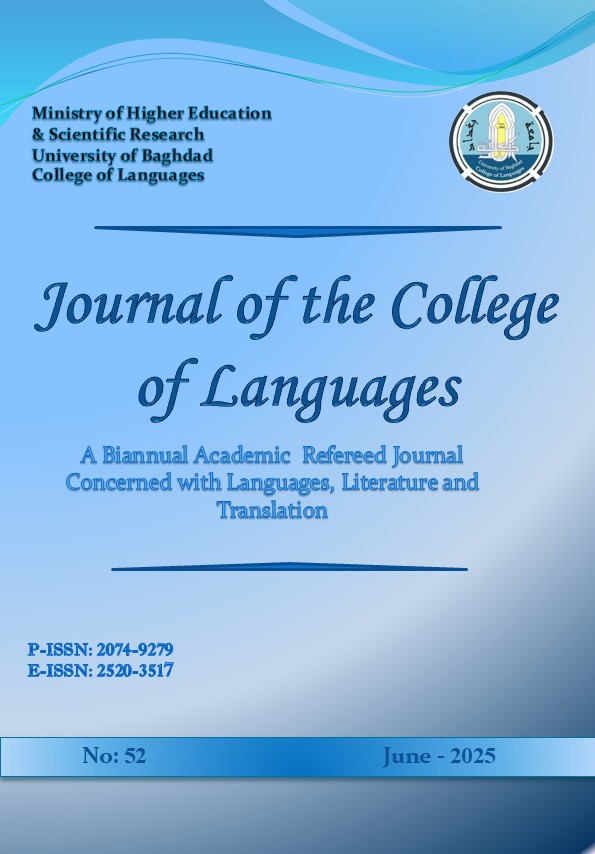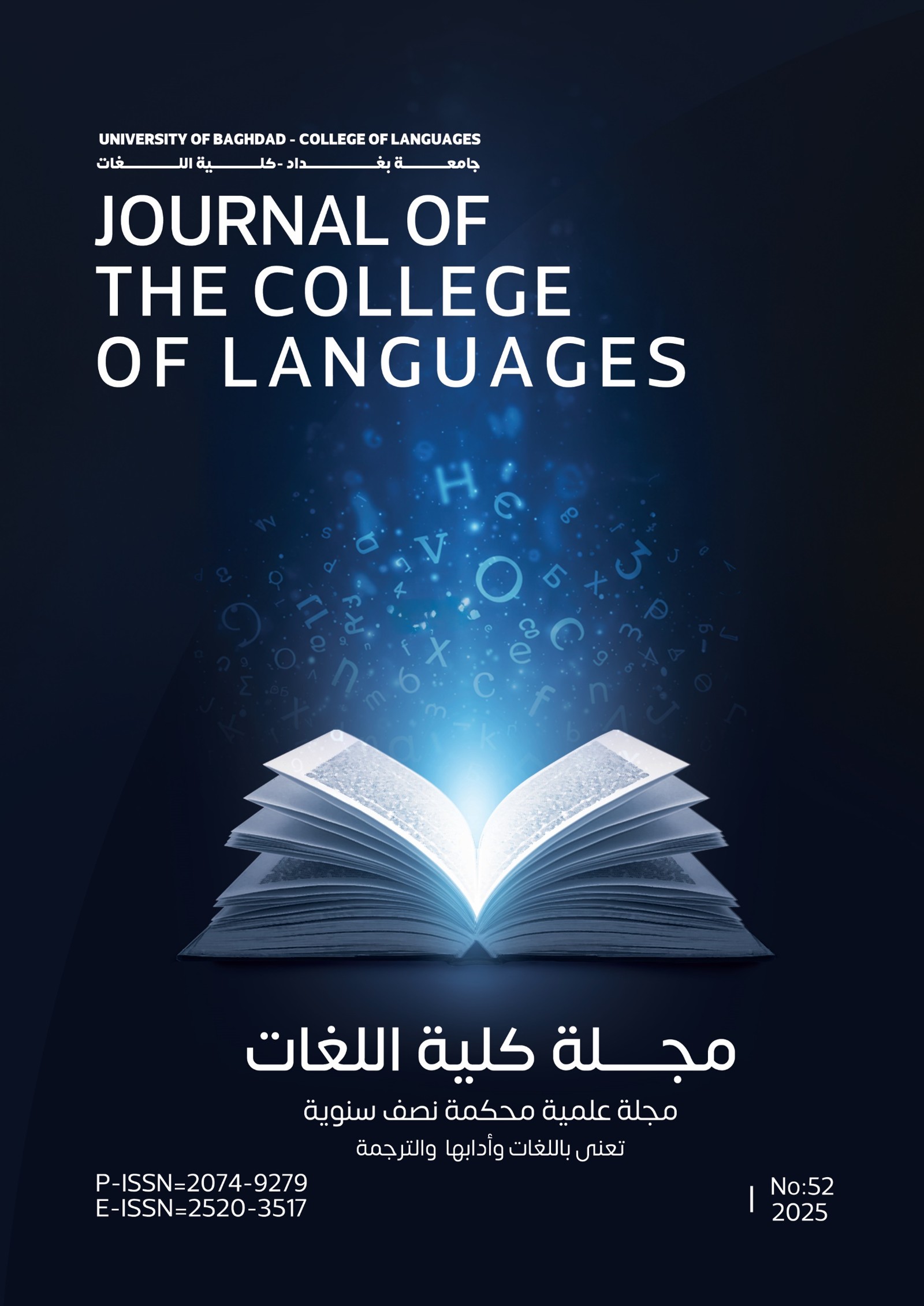The Image of Women Between Two Eras, Eugénie In Eugénie Grandet by Honoré de Balzac and Laura in La fille qu'on appellee by Tanguy Viel as Models
L’image de la femme entre deux époques, Eugénie dans Eugénie Grandet d’Honoré de Balzac et Laura dans La fille qu’on appelle de Tanguy Viel comme modèle
DOI:
https://doi.org/10.36586/jcl.2.2025.0.0155Keywords:
French novel, Women's condition, Patriarchy, Emancipation, Literary compariso, Roman français , Condition féminine , Patriarcat, Émancipation, Comparaison littéraireAbstract
This research explores the image of women between two different eras by comparing the character of Eugénie in the novel Eugénie Grandet by Balzac and the character of Laura in the novel La Fille qu'on appelle by Tanguy Viel. It highlights the changes in the status of women from the 19th century to the present day, with Eugénie reflecting submission to the social norms of her time, while Laura embodies a model of a modern and independent woman who suffers from submission to male political authority.
The research discusses the differences and similarities between the two characters in terms of personal development and social conflicts. It concludes that the French novel, despite its development, still reflects the persistent challenges of women in their quest for independence and freedom. The analysis also highlights significant similarities. Despite the two centuries between them, the two main characters suffer from different manifestations of male oppression. These differences in forms of resistance reflect the depth of social transformations between the two eras. While Eugénie's battle took place within the family and limited surroundings, Laura's struggle expands to the public sphere and authority institutions, revealing new complexities in the forms of male domination in the modern era. In conclusion, the article demonstrates that while French novels reflect evolving social norms, they continue to expose persistent obstacles to female emancipation. The mechanisms of domination have become more sophisticated, but the quest for complete autonomy remains an unfinished struggle.
Résumé
Cet article explore l'image de la femme dans deux époques différentes en comparant le personnage éponyme dans le roman Eugénie Grandet de Balzac et celui de Laura dans le roman La Fille qu'on appelle de Tanguy Viel. Il met en lumière les changements intervenus dans l’évolution du statut des femmes entre le XIXᵉ et le XXIᵉ siècle à travers ces deux romans. Eugénie reflétant la soumission aux mœurs sociales de son époque, tandis que Laura incarne un modèle de femme moderne et indépendante qui souffre de la soumission à l’autorité politique masculine.
L’article analyse les différences et les similitudes entre les deux personnages en termes de transformation des rôles féminins et de conflits sociaux. Il conclut que le roman français, malgré son évolution, reflète encore les défis persistants des femmes dans leur quête d'indépendance et de liberté.
En conclusion, l'article démontre que le roman français, tout en reflétant l'évolution des mœurs, continue de dénoncer les obstacles persistants à l'émancipation féminine. Les mécanismes de domination se sont sophistiqués, mais la quête d'autonomie complète reste un combat inachevé.
References
Colombani, Laetitia, (2017). The Braid. Paris: Grasset.
De Balzac, Honoré, (1970). Eugénie Grandet. Paris: Flammarion.
De Beauvoir, Simone, (1967). The Broken Woman. Paris: Gallimard.
De La Barre, Poulain, (2011). On the Equality of the Two Sexes, the Education of Ladies, and the Excellence of Men, edited and introduced by M.-F. Pellegrin. Paris: Vrin.
De Vigan, Delphine, (2018). Loyalties. Paris: Jean Claude Lattès.
Delon, Michel, (2009). Corinne or the Italy of Madame de Staël: Readings of a Work. Paris: Honoré Champion.
Delon, Michel, (2002). Figures of Women in Balzac. Literary Studies, vol. 34, no. 1.
Duras, Marguerite, (1980). The Room of One's Own. Paris: Les éditions de Minuit.
Frappier-Mazur, Lucienne, (1989). Balzac and the Feminine Imagination. Paris: Presses Universitaires de France.
Giraud, Michel, (2021). The Girl They Call and the Critique of Patriarchal Domination. Le Nouvel Observateur, No. 2937, Paris.
Hugo, Victor, (1970). Songs of Twilight (1835). Complete Works, ed. J. Massin. Paris: Le Club Français du Livre.
Petit, Philippe, (2021). Women in Tanguy Viel. La Nouvelle Revue Française, vol. 612.
Proust, Marcel, (1927). In Search of Lost Time, Part Two. Paris: Gallimard.
Richard, Jean-Pierre, (1970). The Imaginary Universe of Balzac. Paris: Gallimard.
Sartre, Jean-Paul, (1938). Nausea. Paris: Gallimard.
Servan-Schreiber, Sylvie, (2021). Laura, a Symbol of Female Resistance. Le Monde des Livres, No. 2446, Paris.
Slimani, Leïla, (2016). Sweet Song. Paris: Gallimard.
Viel, Tanguy, (2021). The Girl They Call. Paris: Les éditions de Minuit.
Zola, Émile, (1868). The Naturalist Novelists. Paris: Flammarion.
Zancarini-Fournel, Michelle, (2011). Women's Condition, Social Relations of Sex, Gender…, Clio [Online], 32 | 2010, Online since December 31, 2012, p. 122. Connection on April 17, 2024. http://journals.openedition.org/clio/9851. On the Equality of the Two Sexes, the Education of Ladies, and the Excellence of Men, edition and presentation by M.-F. Pellegrin. Paris: Vrin.

Downloads
Published
Issue
Section
License
Copyright (c) 2025 Journal of the College of Languages (JCL)

This work is licensed under a Creative Commons Attribution 4.0 International License.







